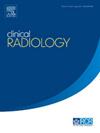T2 mapping in acute myocarditis: advancing quantitative cardiovascular magnetic resonance (CMR) imaging for precision medicine
IF 1.9
3区 医学
Q2 RADIOLOGY, NUCLEAR MEDICINE & MEDICAL IMAGING
引用次数: 0
Abstract
AIM
Myocarditis is an inflammatory condition characterised by myocardial oedema, which is a key diagnostic criterion. The introduction of T2 mapping techniques has enabled the quantitative assessment of myocardial oedema using cardiovascular magnetic resonance (CMR). This study investigated the demographic, laboratory, clinical, and CMR correlates of T2 mapping in patients with acute myocarditis.
MATERIALS AND METHODS
This retrospective study included 141 consecutive patients with acute myocarditis (113 males, mean age 41.12 ± 19.64 years). All patients met the diagnostic criteria for clinically suspected myocarditis with an acute presentation and underwent CMR examinations that fulfilled the Lake Louise Criteria.
RESULTS
The mean T2 mapping value in patients was 60.12 ± 6.28 ms. Significantly higher T2 mapping values were observed in patients with hypertension (P = 0.039), impaired left ventricular ejection fraction (P = 0.001), impaired longitudinal strain (P = 0.002), and late gadolinium enhancement (LGE) in the septum (P = 0.023). On multivariable linear regression analysis, decreased left ventricle ejection fraction (LVEF) (Beta = −2.584, P = 0.014) and greater LGE extent (Beta = 2.166, P = 0.034) were independently associated with elevated T2 mapping values.
CONCLUSION
Elevated T2 mapping values are strongly associated with imaging markers of disease severity in acute myocarditis, underscoring its role in the comprehensive evaluation of myocardial inflammation.
急性心肌炎的T2定位:推进心血管磁共振(CMR)定量成像的精准医学
心肌炎是一种以心肌水肿为特征的炎症,是诊断心肌炎的关键标准。T2定位技术的引入使得使用心血管磁共振(CMR)定量评估心肌水肿成为可能。本研究调查了急性心肌炎患者T2图谱的人口学、实验室、临床和CMR相关性。材料与方法回顾性研究141例急性心肌炎患者(男性113例,平均年龄41.12±19.64岁)。所有患者均符合临床疑似急性心肌炎的诊断标准,并接受了符合Lake Louise标准的CMR检查。结果患者T2测图平均值为60.12±6.28 ms。高血压(P = 0.039)、左室射血分数受损(P = 0.001)、纵向应变受损(P = 0.002)和中隔晚期钆强化(LGE)患者的T2测图值显著升高(P = 0.023)。在多变量线性回归分析中,左心室射血分数(LVEF)降低(Beta = - 2.584, P = 0.014)和LGE程度增大(Beta = 2.166, P = 0.034)与T2映射值升高独立相关。结论T2标测值升高与急性心肌炎疾病严重程度的影像学指标密切相关,在心肌炎症的综合评价中具有重要作用。
本文章由计算机程序翻译,如有差异,请以英文原文为准。
求助全文
约1分钟内获得全文
求助全文
来源期刊

Clinical radiology
医学-核医学
CiteScore
4.70
自引率
3.80%
发文量
528
审稿时长
76 days
期刊介绍:
Clinical Radiology is published by Elsevier on behalf of The Royal College of Radiologists. Clinical Radiology is an International Journal bringing you original research, editorials and review articles on all aspects of diagnostic imaging, including:
• Computed tomography
• Magnetic resonance imaging
• Ultrasonography
• Digital radiology
• Interventional radiology
• Radiography
• Nuclear medicine
Papers on radiological protection, quality assurance, audit in radiology and matters relating to radiological training and education are also included. In addition, each issue contains correspondence, book reviews and notices of forthcoming events.
 求助内容:
求助内容: 应助结果提醒方式:
应助结果提醒方式:


